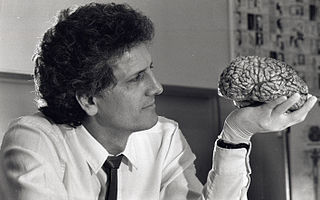
The Institute of Psychiatry, Psychology & Neuroscience (IoPPN) is a leading centre for mental health and neuroscience research, education and training in Europe. It is dedicated to understanding, preventing and treating mental illness, neurological conditions, and other conditions that affect the brain. The IoPPN is a faculty of King's College London, England, and was previously known as the Institute of Psychiatry (IoP).

The Florey Institute of Neuroscience and Mental Health, more commonly known as The Florey, is an Australian medical research institute that undertakes research into treatments for brain and mind disorders. The institute's areas of interest include Parkinson's disease, stroke, motor neurone disease, addiction, epilepsy, multiple sclerosis, Autism, Huntington's disease, depression, schizophrenia, brain function in health and disease, heart failure, and dementia.

Organic brain syndrome, also known as organic brain disease, organic brain damage, organic brain disorder, organic mental syndrome, or organic mental disorder, refers to any syndrome or disorder of mental function whose cause is alleged to be known as organic (physiologic) rather than purely of the mind. These names are older and nearly obsolete general terms from psychiatry, referring to many physical disorders that cause impaired mental function. They are meant to exclude psychiatric disorders. Originally, the term was created to distinguish physical causes of mental impairment from psychiatric disorders, but during the era when this distinction was drawn, not enough was known about brain science for this cause-based classification to be more than educated guesswork labeled with misplaced certainty, which is why it has been deemphasized in current medicine. While mental or behavioural abnormalities related to the dysfunction can be permanent, treating the disease early may prevent permanent damage in addition to fully restoring mental functions. An organic cause to brain dysfunction is suspected when there is no indication of a clearly defined psychiatric or "inorganic" cause, such as a mood disorder.
The Mental Health Research Institute (MHRI) is a former Australian medical research institute that was focused upon improving the diagnosis, treatment and prevention of major mental disorders. The MHRI was active between 1956 and 2012, when it was merged with the Florey Neuroscience Institutes to form the Florey Institute of Neuroscience and Mental Health. Based in Melbourne, Victoria, the research efforts of the MHRI were focused on understanding schizophrenia, bipolar and major mood disorders, and Alzheimer's disease.
John Quinn Trojanowski was an American academic research neuroscientist specializing in neurodegeneration. He and his partner, Virginia Man-Yee Lee, MBA, Ph.D., are noted for identifying the roles of three proteins in neurodegenerative diseases: tau in Alzheimer's disease, alpha-synuclein in Parkinson's disease, and TDP-43 in Amyotrophic Lateral Sclerosis (ALS) and frontotemporal degeneration.

The Black Dog Institute is a not-for-profit facility for diagnosis, treatment and prevention of mood disorders such as depression, anxiety and bipolar disorder. It was founded in 2002 by the UNSW School of Psychiatry Scientia Professor Gordon Parker and is based in Sydney, Australia.
Samuel E. Gandy, is a neurologist, cell biologist, Alzheimer's disease (AD) researcher and expert in the metabolism of the sticky substance called amyloid that clogs the brain in patients with Alzheimer's. His team discovered the first drugs that could lower the formation of amyloid.
The Semel Institute for Neuroscience and Human Behavior is a research institute of the University of California Los Angeles (UCLA). It includes a number of centers, including the "Center for Neurobehavioral Genetics", which uses DNA sequencing, gene expression studies, bioinformatics, and the genetic manipulation of model organisms to understand brain and behavioral phenotypes.
Clinical neuroscience is a branch of neuroscience that focuses on the scientific study of fundamental mechanisms that underlie diseases and disorders of the brain and central nervous system. It seeks to develop new ways of conceptualizing and diagnosing such disorders and ultimately of developing novel treatments.
Perminder Sachdev is an Indian neuropsychiatrist based in Australia. He is a professor of neuropsychiatry at the University of New South Wales (UNSW), co-director of the UNSW Centre for Healthy Brain Aging, and clinical director of the Neuropsychiatric Institute at the Prince of Wales Hospital, Sydney. He is considered a trailblazer in the field of neuropsychiatry. Sachdev's research interests include ageing, vascular cognitive disorders such as vascular dementia, and psychiatric disorders.

George Paxinos AO DSc FASSA FAA FRSN FAHMS is a Greek Australian neuroscientist, born in Ithaca, Greece. He completed his BA in psychology at the University of California at Berkeley and his PhD at McGill University in Montreal, Canada. After a postdoctoral year at Yale University, he moved to the School of Psychology of the University of New South Wales in Sydney, Australia. He is currently an NHMRC Senior Principal Research Fellow at Neuroscience Research Australia and Scientia Professor of Medical Sciences at the University of New South Wales.

The Krembil Research Institute, formerly known as the Toronto Western Research Institute, is an academic medical research institute in Toronto. It is one of the largest research institutes in Canada focusing on human neurological disease.

Richard Allan Bryant is an Australian medical scientist. He is Scientia Professor of Psychology at the University of New South Wales (UNSW) and director of the UNSW Traumatic Stress Clinic, based at UNSW and Westmead Institute for Medical Research. His main areas of research are posttraumatic stress disorder (PTSD) and prolonged grief disorder. On 13 June 2016 he was appointed a Companion of the Order of Australia (AC), for eminent service to medical research in the field of psychotraumatology, as a psychologist and author, to the study of Indigenous mental health, as an advisor to a range of government and international organisations, and to professional societies.
Kaarin Anstey is an Australian Laureate Fellow and one of Australia's top dementia scientists. She is Co-Deputy Director of the ARC Centre of Excellence in Population Ageing Research (CEPAR) at the University of New South Wales, Australia, where she is Scientia Professor of Psychology. Kaarin Anstey is an Honorary Professor at the Australian National University and a Fellow of the Academy of the Social Sciences in Australia. She is a Director of the NHMRC Dementia Centre for Research Collaboration, Senior Principal Research Scientist at NeuRA and leads the NHMRC Centre of Research Excellence in Cognitive Health and the UNSW Ageing Futures Institute.

Dr. Natalie Matosin is an Australian scientist known for research into the impacts of the human brain in health and disease, and particularly stress and its role in mental illness. Matosin's research has been published in prestigious academic journals, as well as on The Conversation. Matosin spoke at TEDx Hamburg in June 2017 and is the 2021 Al & Val Rosenstrauss Fellow. She was previously a National Health and Medical Research Council CJ Martin Early Career Research Fellow, and Alexander von Humboldt Fellow. In 2017, Matosin was listed as a Forbes 30 Under 30 in Europe in the category of Science & Healthcare, placing her in the top 1% of innovators worldwide.
Bettina Meiser is a professor at the University of New South Wales, with expertise in the psychosocial aspects of genetics; cancer, hereditary cancer, and the impact of genetic counselling and testing.
Simon Gandevia is from Melbourne, Australia. He studied at the University of New South Wales where he received three research doctorates: PhD, MD, and DSc. Gandevia's current research focuses primarily on the relationship between the human brain and movement. His work contributes to various sub-fields within medicine particularly focusing on pathological mechanisms, such as neurology, cardiorespiratory medicine and rehabilitation. In addition, he worked with many editorial boards such as the Journal of Physiology. Gandevia had supervised and trained several doctoral students. Gandevia also writes about research ethics and quality of experimental procedures in order to facilitate the development of concepts about ethics in human experimental studies. In 1998, Gandevia was elected a Fellow of the Australian Academy of Science, and the Australian Academy of Health and Medical Science in 2016.
Joseph Thomas Coyle Jr. is an American psychiatrist and neuroscientist. He is the Eben S. Draper Professor of Psychiatry and Neuroscience at Harvard Medical School.
Glenda Margaret Halliday is an Australian neuroscientist. As of 2021, she is a professor at the University of Sydney and research fellow in the National Health and Medical Research Council (NHMRC). She was named 2022 NSW Scientist of the Year.








